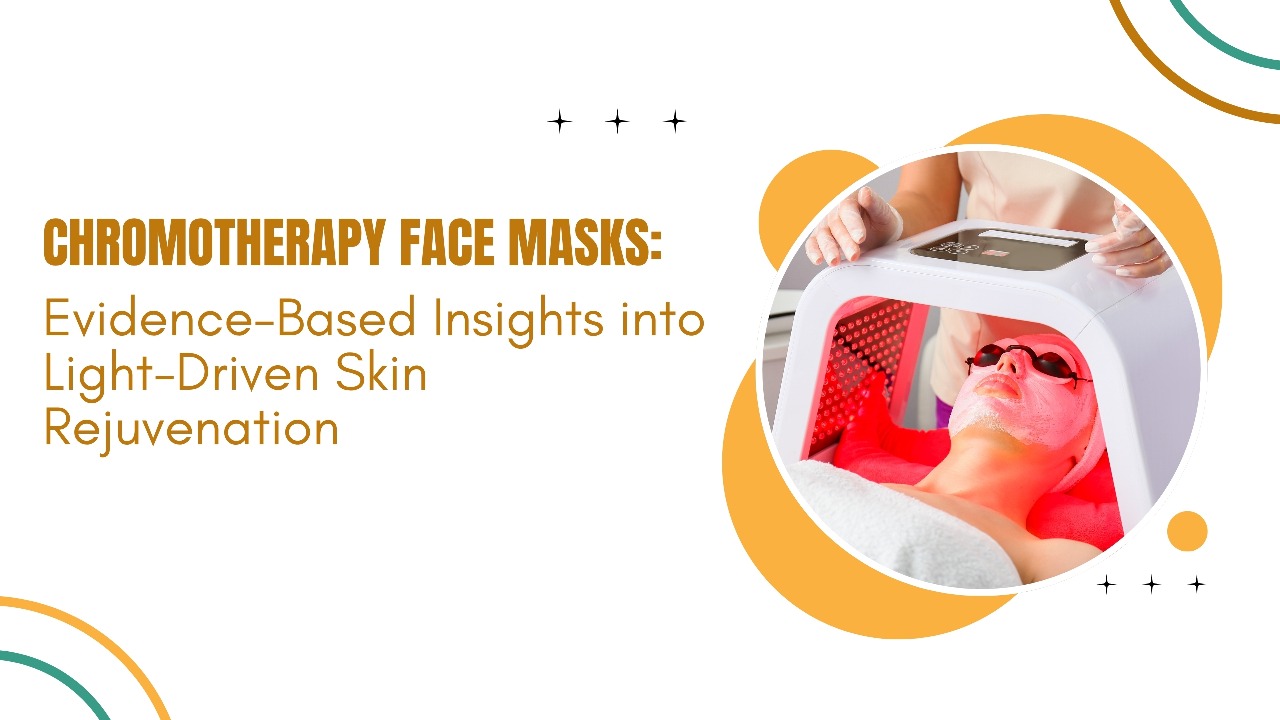Introduction: Light as a Therapeutic Modality
Chromotherapy, or color therapy, has historical roots in Ayurvedic, Egyptian, and Greek medicine, where colored light was believed to influence physiological and psychological health. Contemporary science has validated these concepts through photobiomodulation (PBM), where specific wavelengths of visible and near-infrared light modulate cellular processes at the mitochondrial and molecular level.
LED and infrared (IR) face masks now translate this principle into clinically measurable dermatologic effects, offering non-invasive alternatives for skin rejuvenation, anti-aging, and inflammatory modulation.
Mechanistic Basis of Chromotherapy
The primary mechanism of LED and IR phototherapy involves absorption of photons by chromophores, predominantly cytochrome c oxidase (CCO) in the mitochondrial electron transport chain. Photon absorption results in:
- Enhanced ATP synthesis, providing energy for cellular repair and metabolic functions
- Transient ROS signaling, which activates gene transcription related to collagen synthesis and tissue regeneration
- Modulation of inflammatory mediators such as TNF-α and IL-6, promoting anti-inflammatory effects
- Angiogenesis and microcirculation enhancement, improving oxygen and nutrient delivery
Cumulatively, these effects support fibroblast proliferation, keratinocyte differentiation, and extracellular matrix remodeling, underpinning improvements in skin texture, elasticity, and hydration.
Clinical Evidence
1. Home-Use LED and Infrared Mask Trial (2025)
- Reference: Park S. et al., Medicine (Baltimore), 2025
- Design: Multicenter, randomized, double-blind, sham-controlled trial
- Population: Adults aged 30–65 with crow’s feet
- Intervention: Combined LED (600–660 nm) + IR (800–860 nm), 20 minutes/day for 8 weeks
- Outcomes: 23–27% reduction in wrinkle depth; significant improvement in skin elasticity and hydration; high compliance; no adverse events
This trial demonstrates the efficacy and safety of home-use photobiomodulation, establishing LED/IR masks as a validated dermatologic intervention.
Systematic Safety Review (2023)
- Reference: Ryu H. et al., Lasers Surg Med.
- Findings: No evidence of DNA damage, tumorigenesis, or abnormal proliferation with low-level phototherapy (≤10 J/cm²)
- Implication: Repeated exposure is oncologically safe, supporting chronic application in aesthetic medicine.
- Integrative Implications
In integrative medicine and naturopathy, photobiomodulation exemplifies non-invasive cellular optimization. By enhancing mitochondrial efficiency and modulating inflammation, LED therapy complements:
- Nutritional support (antioxidants, vitamins)
- Hydration optimization
- Stress-reduction practices (yoga, breathwork)
This synergy aligns with the principle of Vis Medicatrix Naturae, reinforcing the body’s intrinsic regenerative capacity while offering quantifiable, evidence-based dermatologic benefits.
Future Directions: Personalized Photomedicine
Emerging technologies incorporate biosensors and AI algorithms to dynamically adjust wavelength, intensity, and exposure duration based on:
- Skin hydration and oxygenation
- Phototype and pigmentation
- Circadian rhythm and cellular metabolic status
This represents the advent of adaptive photomedicine, allowing individualized, data-driven skin therapy that maximizes efficacy and safety.
Conclusion
Chromotherapy face masks are no longer mere cosmetic devices; they are scientifically validated tools that leverage photobiomodulation to optimize cellular function. Red and near-infrared light safely enhance collagen synthesis, tissue repair, and skin homeostasis, offering a mechanistically supported approach to non-invasive skin rejuvenation.
Light is not just illumination — it is bioenergetic therapy, capable of restoring skin vitality at the cellular level.
References (Open Access Only)
- Park S. et al. Clinical Study to Evaluate the Efficacy and Safety of Home-Used LED and IRED Mask for Crow’s Feet. Medicine (Baltimore), 2025. Open Access Link
- Kim J. et al. Unlocking the Power of Light on the Skin: A Comprehensive Review on Photobiomodulation. International Journal of Molecular Sciences, 2024. Open Access Link
- Ryu H. et al. Photobiomodulation: A Systematic Review of the Oncologic Safety of Low-Level Light Therapy. Lasers in Surgery and Medicine, 2023.
Written by -Dharmik Gada


